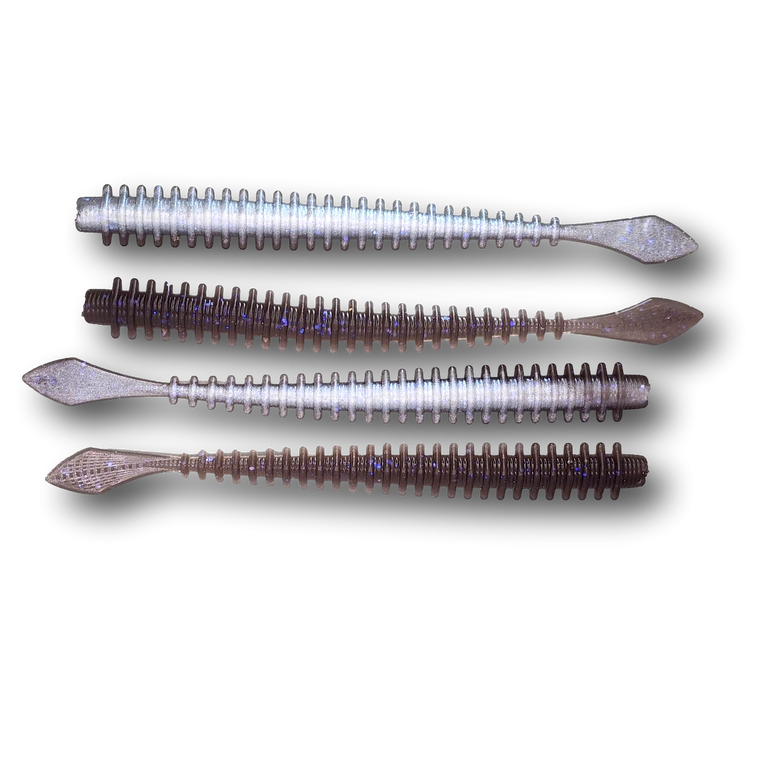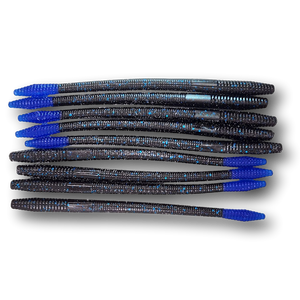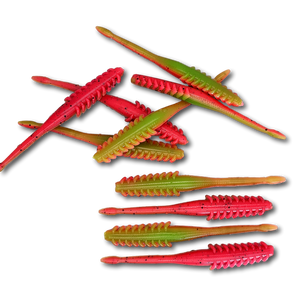
Four-Seven Lures 7 Inch Flex Rib Finesse Worm Soft Plastic Bait
Four-Seven LuresCarolina Rig (1/4–1/2 oz • 18–30" leader)
When & where: Offshore points, shell beds, subtle drops where fish track bottom in warm water.
How: Slow drag, pause, feed slack. The ribbed body of the FlexRib moves water the whole time and the tail keeps quivering when the weight is parked.
Why: Long leader + a buoyant, fully ribbed worm gives you constant life even when you’re not moving it.
Drop Shot (long worm / mag finesse)
When & where: Vertical brush piles, docks in 12–20 ft, fish you can see on forward‑facing that won’t eat a jig.
How: Nose‑ or mid‑hook. Shake slack, not the worm. The ribs trap tiny bubbles and make micro‑vibration without big rod movement.
Neko Rig (nail weight in head)
When & where: High‑pressure marinas, docks, isolated brush where everyone else is pitching a creature bait.
How: Light pop of the rod tip, then let it settle nose‑down. The tail stands up and shivers because the ribs flex along the full length.
Hook: Weedless finesse Neko hook through the banded mid‑section.
Texas Rig (3/16–5/16 oz • pegged or semi‑pegged)
When & where: Grass edges, brush piles, isolated stumps, river wood. Classic "big worm" situations where you still want finesse instead of a bulky creature.
How: Pitch, let it fall on semi‑slack, then drag‑hop‑pause. The FlexRib’s ribs keep moving water without you having to overwork it, which is huge in post‑front funk.
Hook: 3/0–5/0 offset or straight‑shank. Skin‑hook the point to stay clean in cover.
Wacky Rig (O‑ring mid‑body)
When & where: Post‑spawn shade lines, seawalls, boat slips. This is the "I just need bites" mode.
How: Cast, count it down on slack. Both halves pulse and flex because the worm is ribbed the whole way, not smooth like a stick bait.
Weightless Rig (Texas or straight‑shank hook)
When & where: Flooded bushes, narrow cuts, bank grass in low light.
How: Glide it through, kill it in the pocket, give one shake. The ribs kick tiny pulses that make the worm feel alive without big tail swing.
Trim & Mods (quick hits)
- Neko band insurance: Run an O‑ring/band on the mid‑body before inserting the nail weight so fish don’t tear the worm in half on the hookset.
- Shorten the tail: If they’re just nipping, cut 1/2" off the tail end. You’ll get a tighter quiver and more head‑first eats.
- Glass rattle: Slide a small rattle into the tail segment for dirty water or night dragging on a Carolina rig.
- Natural / Green Pumpkin family: Green Pumpkin, GP w/ Purple, Watermelon variants. Throw this around grass, wood, docks, and in 2–6 ft clarity. It reads as bluegill, leech, or just "something alive" without screaming "lure."
- Dark / Silhouette: Black Sapphire, Junebug, Black Blue. Money in mud, low light, or tannic river water. Also good at night for slow Texas drags or Carolina pulls on hard spots.
- Plum / Red Bug / Motor Oil w/ Flake: Classic warm‑water ledge and brush colors. Offshore bass have been chewing purple and red worms for decades; that hasn’t changed.
- Chartreuse / High‑Viz Tails: Chartreuse‑dipped tails, sprayed grass, fire tiger blends. Use in churned water or when you want them to visually track the bait on a slow fall.
- Length: 7" class mag‑finesse worm (8‑pack).
- Profile: Full‑length ribbed body (flex ribs from head to tail) that compresses on the bite, moves water at slow speed, and throws micro vibration on even tiny rod shakes.
- Action: The ribs let the whole worm "breathe" instead of just the tip shaking. On slack line it still pulses, which is why it wins on pressured fish that won’t eat a bulk creature.
- Material: Soft plastisol.
- Best Pairings: Texas (3/16–5/16 pegged), Carolina (1/4–1/2 + 18–30" leader), Neko (nail weight in head), Wacky (mid‑band), Magnum Drop Shot (nose/mid‑hook), Weightless (targeted glide into cover).
- Hook Sizes: 3/0–5/0 offset EWG or straight‑shank for Texas/weightless; finesse Neko/wacky hook through the band for docks; light‑wire #1–1/0 for drop shot if you’re doing the "mag finesse" vertical thing.
- Species: Largemouth / Smallmouth / Spots.
- Availability: Poured in small batches; built to fish, not sit on a peg forever. Warm plastic, fresh color, current pour.
Care & Storage
Keep worms straight in the original sleeve so the body doesn’t kink. Don’t leave them cooked on the carpet or deck; heat can warp the ribs and lock in a curve.
Plastics Recycling
Recycle or dispose of torn baits properly. Learn more here: Soft Plastics Recycling.
On‑the‑Water Notes
- Post‑front stall bite: Texas rig it and not move it much. The ribs keep breathing in place, which sells neutral bass that won’t chase a jig or chatter.
- Summer brush / ledges: Carolina rig, long drag, pause on contact. Feed slack and count to 2–3. Most bites are just "weight" when you lean back.
- High‑pressure docks: Neko or wacky. You’re basically running a finesse presentation but with a long worm silhouette they haven’t already seen 400 times.
Q&A
Q: Why a 7" finesse worm instead of a 4–5" finesse worm?
A: You still get the subtle, pressured‑fish shimmy, but you’ve added big‑meal confidence. It targets better‑quality bites without giving up finesse behavior.
Q: Spinning or casting?
A: Texas / Carolina = MH baitcaster, 12–17 lb fluoro (or braid + leader in grass). Neko / wacky / long drop shot = 7' ML/M spinning, 10–15 lb braid main line to 8–12 lb fluoro leader.
Related Products
- Barracuda 5.5" Worm w/ Kicker Tail — compact kicker tail when you want shorter but still active.
- Barracuda 6" Paddle Tail Worm — paddle tail thump for grass lines and swim‑style Texas retrieves.
- Barracuda 7" Worm w/ Kicker Tail — similar size class with a different tail signal for rotation on pressured fish.
- Barracuda 8" Paddle Tail Worm — step up in profile when you’re swinging for a bigger bite offshore or at night.









